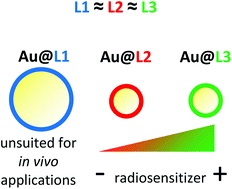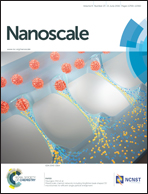Minor changes in the macrocyclic ligands but major consequences on the efficiency of gold nanoparticles designed for radiosensitization†
Abstract
Many studies have been devoted to adapting the design of gold nanoparticles to efficiently exploit their promising capability to enhance the effects of radiotherapy. In particular, the addition of magnetic resonance imaging modality constitutes an attractive strategy for enhancing the selectivity of radiotherapy since it allows the determination of the most suited delay between the injection of nanoparticles and irradiation. This requires the functionalization of the gold core by an organic shell composed of thiolated gadolinium chelates. The risk of nephrogenic systemic fibrosis induced by the release of gadolinium ions should encourage the use of macrocyclic chelators which form highly stable and inert complexes with gadolinium ions. In this context, three types of gold nanoparticles (Au@DTDOTA, Au@TADOTA and Au@TADOTAGA) combining MRI, nuclear imaging and radiosensitization have been developed with different macrocyclic ligands anchored onto the gold cores. Despite similarities in size and organic shell composition, the distribution of gadolinium chelate-coated gold nanoparticles (Au@TADOTA-Gd and Au@TADOTAGA-Gd) in the tumor zone is clearly different. As a result, the intravenous injection of Au@TADOTAGA-Gd prior to the irradiation of 9L gliosarcoma bearing rats leads to the highest increase in lifespan whereas the radiophysical effects of Au@TADOTAGA-Gd and Au@TADOTA-Gd are very similar.


 Please wait while we load your content...
Please wait while we load your content...